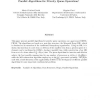Free Online Productivity Tools
i2Speak
i2Symbol
i2OCR
iTex2Img
iWeb2Print
iWeb2Shot
i2Type
iPdf2Split
iPdf2Merge
i2Bopomofo
i2Arabic
i2Style
i2Image
i2PDF
iLatex2Rtf
Sci2ools
113
click to vote
SWAT
1992
Springer
1992
Springer
Parallel Algorithms for Priority Queue Operations
This paper presents parallel algorithms for priority queue operations on a p-processor EREWPRAM. The algorithms are based on a new data structure, the Min-path Heap (MH), which is obtained as an extension of the traditional binary-heap organization. Using an MH, it is shown that insertion of a new item or deletion of the smallest item from a priority queue of n elements can be performed in O(logn p + loglogn) parallel time, while construction of an MH from a set of n items takes O(n p +logn) time. The given algorithms for insertion and deletion achieve the best possible running time for any number of processors p, with p 2 O( logn loglogn), while the MH construction algorithm employs up to ( n logn) processors optimally. The paper ends with a brief discussion of the applicability of MH's to the development of e cient parallel algorithms for some important combinatorial problems. Keywords Analysis of Algorithms, Data Structures, Heaps, Parallel Algorithms. This work was supported ...
Related Content
| Added | 11 Aug 2010 |
| Updated | 11 Aug 2010 |
| Type | Conference |
| Year | 1992 |
| Where | SWAT |
| Authors | Maria Cristina Pinotti, Geppino Pucci |
Comments (0)

